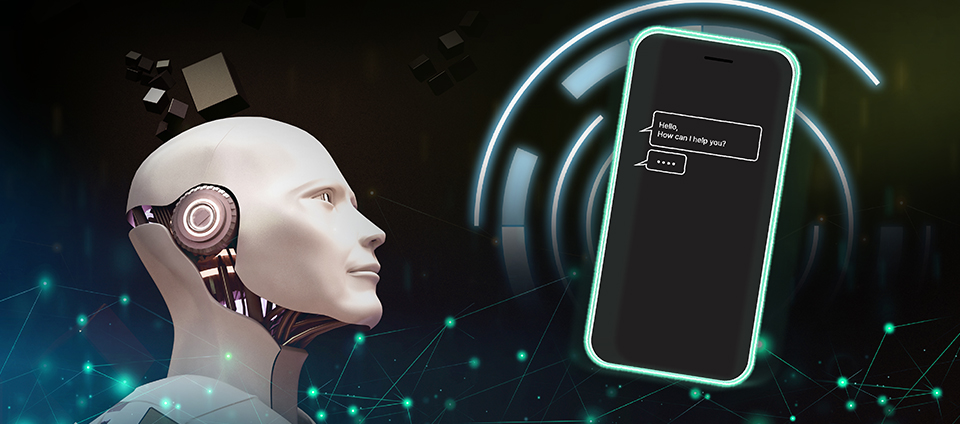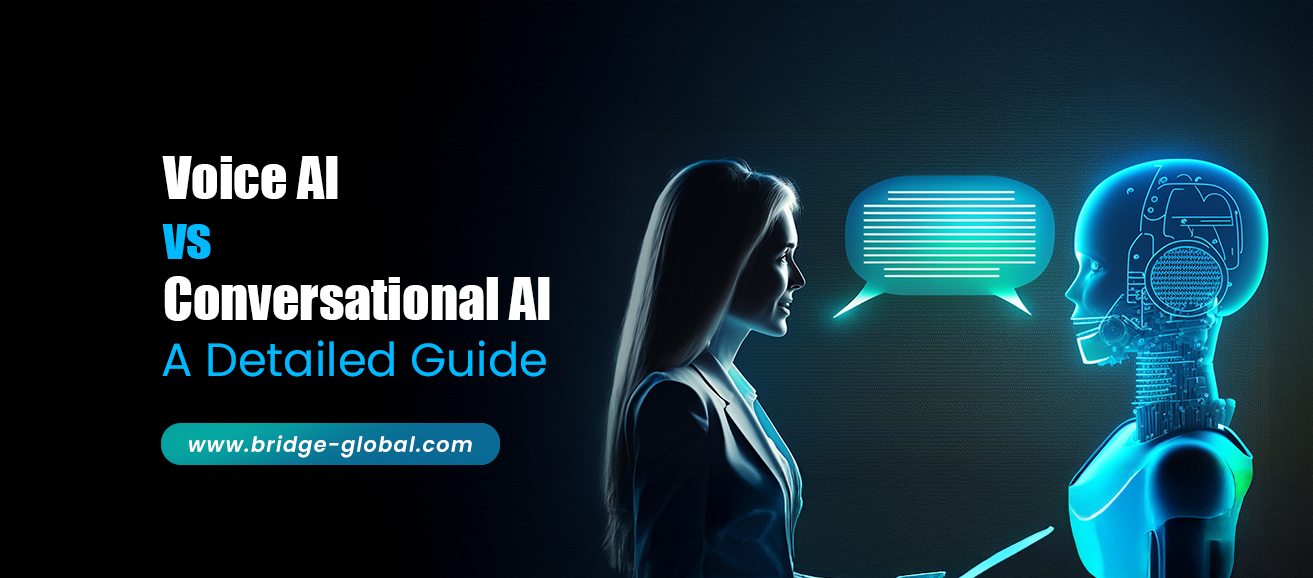Voice AI vs Conversational AI: A Complete Guide to Smarter Customer Engagement
With many brands dipping their toes into the voice-first era, several terms and definitions have either changed or are being used interchangeably. Terms like voice only, voice-first, voice user interface, voice assistant, and voice AI are all context-specific, referring to the technology, strategy, or the final product and user experience.
Two terms that originated from different backgrounds but are now frequently used almost interchangeably are voice AI and conversational AI. Initially, conversational AI referred to the pop-up bots found on customer service websites. Still, its definition has since evolved to encompass the most sophisticated and natural language voice user interfaces available.
Understanding Voice AI

What It Is:
Voice AI refers to technologies that allow machines to listen to, understand, and respond to spoken language. It uses sophisticated algorithms and machine learning models to interpret audio input and produce meaningful, real-time responses.
Where It’s Used:
Smart virtual assistants like Google Assistant and Alexa
Hands-free controls for smart home or IoT systems
Voice-enabled customer support platforms that speed up issue resolution
Example in Action:
When a user asks, “Alexa, what’s the weather today?”, the device converts the speech into text, interprets the request, retrieves the forecast, and responds with a natural-sounding voice.
Why It Matters:
Voice AI creates more natural, effortless interactions with technology, enabling broader accessibility and enhancing user convenience, especially in hands-free scenarios.
Understanding Conversational AI

What It Is:
Conversational AI is a specialized application of AI that enables systems to participate in human-like conversations. It typically combines rule-based logic with natural language processing to simulate interactive dialogue, whether through text or voice.
Core Capabilities:
- Intent Detection: Understands what the user wants to achieve from their message
- Context Awareness: Keeps track of the conversation’s flow, even across multiple exchanges
- Scripted Responses: Follows structured dialogues to ensure clarity and consistency
Where It’s Used:
Interactive voice response (IVR) systems that guide callers through service menus
Chatbots on websites and apps for handling customer queries
Ecommerce platforms to help users search products or get personalized suggestions
Why It Matters:
Conversational AI streamlines customer service by handling frequent, repetitive inquiries, cutting down wait times, and boosting overall satisfaction.
Example in Action:
In a support call, an automated IVR might ask, “How can I assist you today?” and based on the spoken response, direct the caller to the appropriate department.
Difference Between Conversational AI and Voice AI

Primary Modality
Conversational AI is typically designed with text-based interactions in mind. While it may include basic voice capabilities, its primary focus is often on chat interfaces like website bots or messaging apps.
Voice AI, on the other hand, is built with voice as the central mode of communication. It is engineered specifically for spoken conversations and tailored for voice-first experiences.
Core Technologies
Conversational AI relies heavily on Natural Language Processing (NLP), Natural Language Understanding (NLU), Dialogue Management, and Natural Language Generation (NLG). Some systems may also integrate Automatic Speech Recognition (ASR) and Text-to-Speech (TTS), though they are not always the core focus.
Voice AI incorporates all of these technologies as well—but with a stronger emphasis on optimizing ASR, TTS, NLP, and NLU specifically for voice-based use cases, ensuring smooth and lifelike phone interactions.
Real-time Processing
Conversational AI systems typically operate in turn-based or asynchronous modes, which work well for text chats that allow natural pauses and delays.
Voice AI is built for real-time conversations. It processes input and generates responses within seconds during live phone calls, ensuring fluid and uninterrupted communication.
Depth of Understanding
Conversational AI mainly extracts user intent from written text or voice-to-text conversion. It tends to focus more on what is said than how it is said.
Voice AI goes deeper. In addition to understanding the spoken words, it analyzes vocal cues such as tone, emotion, and hesitation. This allows it to respond more empathetically and adaptively during live calls.
Specialized Capabilities
Conversational AI is often used for straightforward tasks like answering FAQs, capturing basic user input, or helping with guided workflows.
Voice AI takes on more advanced challenges. It’s equipped to recognize speech in noisy environments, handle various accents, detect emotional states, and carry contextual memory across longer conversations for a more human-like experience.
Typical Use Cases in Customer Service
Conversational AI shines in environments like website support chats, messaging apps, email responses, and simple phone menus (IVR systems).
Voice AI is purpose-built for phone-based interactions. It powers intelligent voice agents, enhances live agent performance through real-time assistance, and helps navigate complex IVR systems with greater ease.
Complexity of Interaction Handled
Conversational AI is most effective in predictable, rule-based scenarios. It may struggle to manage long or highly nuanced conversations.
Voice AI excels at managing spontaneous, context-rich, and extended dialogues. It can handle shifts in tone, intent, or emotion during a conversation, making it ideal for voice-based customer support.
Primary Goal
Conversational AI aims to automate communication across a wide range of platforms like web, messaging apps, and more, mainly through text.
Voice AI is designed to elevate spoken interactions. Its goal is to streamline and enhance the quality of live phone conversations for both customers and agents.
Impact on Phone Support
Conversational AI can assist with basic voice automation or routing calls based on keywords or intent.
Voice AI is transforming phone-based customer service. It enables personalized, natural-sounding conversations, supports agents in real time, and brings rich insights through advanced call analytics.
Which AI Solution Fits Your Customer Service Needs?
When it comes to choosing between Voice AI and Conversational AI for customer service, it’s important to understand that these technologies aren't in competition and that they often work best when used together.
Rather than treating it as an either/or decision, the right choice depends on the type of customer service processes you’re aiming to improve or automate:
For multi-channel support involving simpler, text-based interactions: If your focus is on deploying chatbots on your website, managing routine questions on messaging platforms, handling email queries, or setting up FAQ bots across digital touchpoints, then a comprehensive Conversational AI solution is a great place to begin.
For enhancing phone-based support and managing real-time voice interactions: If you're aiming to elevate customer experiences over the phone – whether through real-time assistance for agents, intelligent voice bots that manage complex conversations, or tools that analyze speech for emotional tone and intent, then robust Voice AI capabilities are essential.
Ultimately, the goal is to align each technology with the specific needs of your customer service environment. By matching the strengths of Voice AI and Conversational AI to the demands of each communication channel, you can create a more efficient and satisfying customer experience across the board.
The Wrap
Voice AI and Conversational AI occupy distinct yet complementary roles within the landscape of AI-powered customer engagement. Instead of viewing them as alternatives, innovative businesses are leveraging both by using Conversational AI to manage text-based interactions across chat, email, and messaging platforms, while deploying Voice AI to revolutionize customer experiences over the phone.
By integrating both technologies strategically, companies can create a seamless, channel-specific support system that enhances efficiency and satisfaction at every touchpoint. You can leverage both these technologies by partnering with an experienced and reliable AI development company that offers top-notch artificial intelligence development, generative AI development, AI integration services, and much more!



